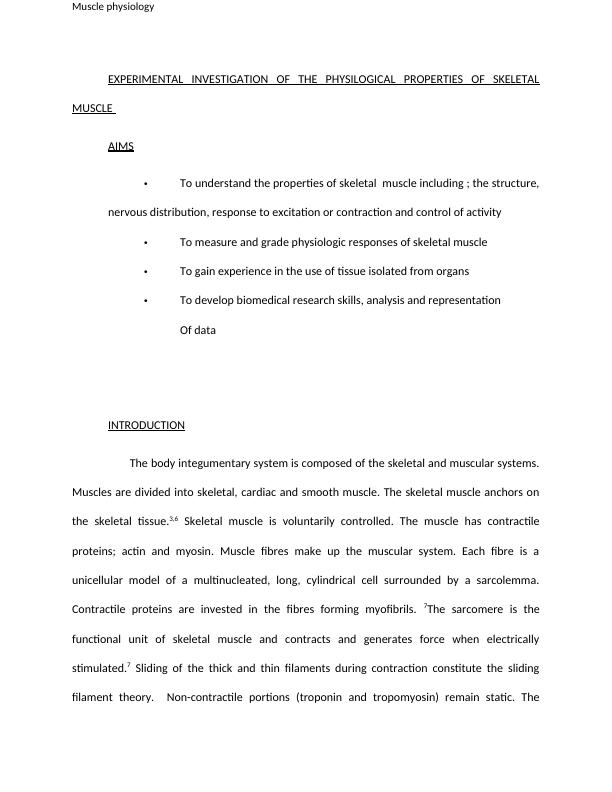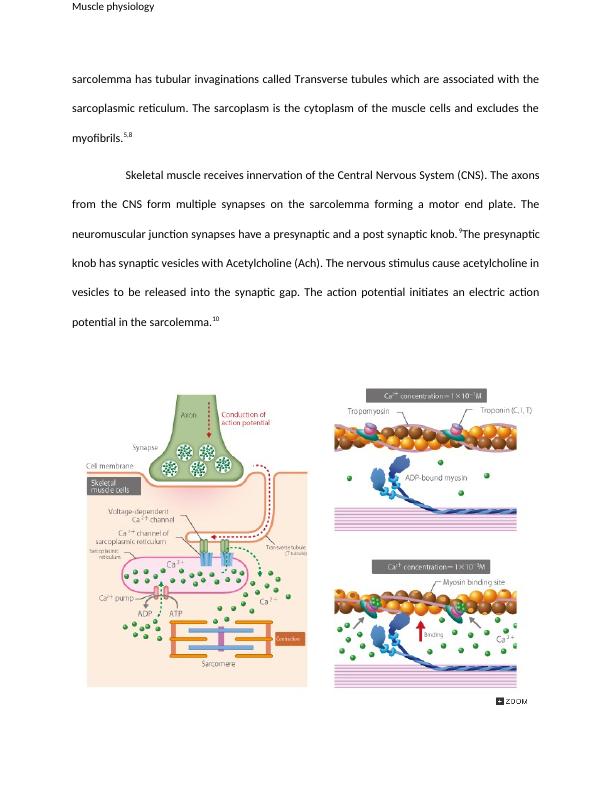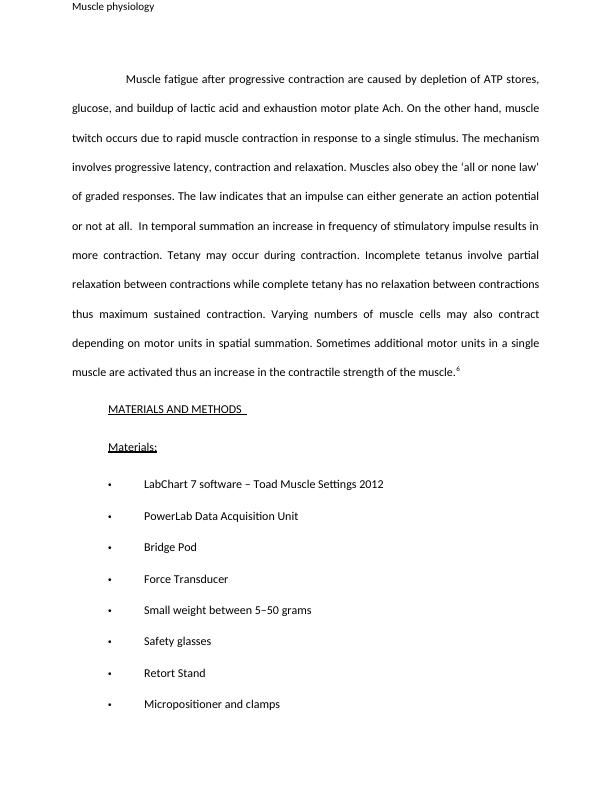Experimental Investigation of the Physiological Properties of Skeletal Muscle
Added on 2023-06-13
12 Pages1910 Words115 Views
Muscle physiology
EXPERIMENTAL INVESTIGATION OF THE PHYSILOGICAL PROPERTIES OF SKELETAL
MUSCLE
AIMS
• To understand the properties of skeletal muscle including ; the structure,
nervous distribution, response to excitation or contraction and control of activity
• To measure and grade physiologic responses of skeletal muscle
• To gain experience in the use of tissue isolated from organs
• To develop biomedical research skills, analysis and representation
Of data
INTRODUCTION
The body integumentary system is composed of the skeletal and muscular systems.
Muscles are divided into skeletal, cardiac and smooth muscle. The skeletal muscle anchors on
the skeletal tissue.3,6 Skeletal muscle is voluntarily controlled. The muscle has contractile
proteins; actin and myosin. Muscle fibres make up the muscular system. Each fibre is a
unicellular model of a multinucleated, long, cylindrical cell surrounded by a sarcolemma.
Contractile proteins are invested in the fibres forming myofibrils. 7The sarcomere is the
functional unit of skeletal muscle and contracts and generates force when electrically
stimulated.7 Sliding of the thick and thin filaments during contraction constitute the sliding
filament theory. Non-contractile portions (troponin and tropomyosin) remain static. The
EXPERIMENTAL INVESTIGATION OF THE PHYSILOGICAL PROPERTIES OF SKELETAL
MUSCLE
AIMS
• To understand the properties of skeletal muscle including ; the structure,
nervous distribution, response to excitation or contraction and control of activity
• To measure and grade physiologic responses of skeletal muscle
• To gain experience in the use of tissue isolated from organs
• To develop biomedical research skills, analysis and representation
Of data
INTRODUCTION
The body integumentary system is composed of the skeletal and muscular systems.
Muscles are divided into skeletal, cardiac and smooth muscle. The skeletal muscle anchors on
the skeletal tissue.3,6 Skeletal muscle is voluntarily controlled. The muscle has contractile
proteins; actin and myosin. Muscle fibres make up the muscular system. Each fibre is a
unicellular model of a multinucleated, long, cylindrical cell surrounded by a sarcolemma.
Contractile proteins are invested in the fibres forming myofibrils. 7The sarcomere is the
functional unit of skeletal muscle and contracts and generates force when electrically
stimulated.7 Sliding of the thick and thin filaments during contraction constitute the sliding
filament theory. Non-contractile portions (troponin and tropomyosin) remain static. The

Muscle physiology
sarcolemma has tubular invaginations called Transverse tubules which are associated with the
sarcoplasmic reticulum. The sarcoplasm is the cytoplasm of the muscle cells and excludes the
myofibrils.5,8
Skeletal muscle receives innervation of the Central Nervous System (CNS). The axons
from the CNS form multiple synapses on the sarcolemma forming a motor end plate. The
neuromuscular junction synapses have a presynaptic and a post synaptic knob.9The presynaptic
knob has synaptic vesicles with Acetylcholine (Ach). The nervous stimulus cause acetylcholine in
vesicles to be released into the synaptic gap. The action potential initiates an electric action
potential in the sarcolemma.10
sarcolemma has tubular invaginations called Transverse tubules which are associated with the
sarcoplasmic reticulum. The sarcoplasm is the cytoplasm of the muscle cells and excludes the
myofibrils.5,8
Skeletal muscle receives innervation of the Central Nervous System (CNS). The axons
from the CNS form multiple synapses on the sarcolemma forming a motor end plate. The
neuromuscular junction synapses have a presynaptic and a post synaptic knob.9The presynaptic
knob has synaptic vesicles with Acetylcholine (Ach). The nervous stimulus cause acetylcholine in
vesicles to be released into the synaptic gap. The action potential initiates an electric action
potential in the sarcolemma.10

Muscle physiology
The Ach released from the initiation of the action potential binds the nicotinic
receptors at the motor end plate allowing Na= influx this depolarizing the sarcolemma. Impulse
from the resultant action potential spread rapidly through the transverse tubules especially on
the terminal cisternae where dihydropyridine (DHP) receptors are triggered.6,8,10 The
sarcoplasmic reticulum releases Calcium ions stored in the sarcoplasm. Calcium ions bind
troponin changing conformation and allowing movement of tropomyosin from the active site
on actin. Exposed actin results in myosin binding on its active site.5 The binding of actin to
myosin forms a cross bridge which stimulates ATPase activity thus power stroke occurs, this is
the ‘pulling’ of actin towards the M line by pivoting of the myosin head. In the power stroke the
myosin head moved from a high energy state to a low energy state.7 ATP serves to break the
cross bridge and repositioning of myosin. The repeat of the contraction occurs until the impulse
is stopped of depletion of ATP occurs; this called fatigue.
The Ach released from the initiation of the action potential binds the nicotinic
receptors at the motor end plate allowing Na= influx this depolarizing the sarcolemma. Impulse
from the resultant action potential spread rapidly through the transverse tubules especially on
the terminal cisternae where dihydropyridine (DHP) receptors are triggered.6,8,10 The
sarcoplasmic reticulum releases Calcium ions stored in the sarcoplasm. Calcium ions bind
troponin changing conformation and allowing movement of tropomyosin from the active site
on actin. Exposed actin results in myosin binding on its active site.5 The binding of actin to
myosin forms a cross bridge which stimulates ATPase activity thus power stroke occurs, this is
the ‘pulling’ of actin towards the M line by pivoting of the myosin head. In the power stroke the
myosin head moved from a high energy state to a low energy state.7 ATP serves to break the
cross bridge and repositioning of myosin. The repeat of the contraction occurs until the impulse
is stopped of depletion of ATP occurs; this called fatigue.

Muscle physiology
Muscle fatigue after progressive contraction are caused by depletion of ATP stores,
glucose, and buildup of lactic acid and exhaustion motor plate Ach. On the other hand, muscle
twitch occurs due to rapid muscle contraction in response to a single stimulus. The mechanism
involves progressive latency, contraction and relaxation. Muscles also obey the ‘all or none law’
of graded responses. The law indicates that an impulse can either generate an action potential
or not at all. In temporal summation an increase in frequency of stimulatory impulse results in
more contraction. Tetany may occur during contraction. Incomplete tetanus involve partial
relaxation between contractions while complete tetany has no relaxation between contractions
thus maximum sustained contraction. Varying numbers of muscle cells may also contract
depending on motor units in spatial summation. Sometimes additional motor units in a single
muscle are activated thus an increase in the contractile strength of the muscle.6
MATERIALS AND METHODS
Materials;
• LabChart 7 software – Toad Muscle Settings 2012
• PowerLab Data Acquisition Unit
• Bridge Pod
• Force Transducer
• Small weight between 5–50 grams
• Safety glasses
• Retort Stand
• Micropositioner and clamps
Muscle fatigue after progressive contraction are caused by depletion of ATP stores,
glucose, and buildup of lactic acid and exhaustion motor plate Ach. On the other hand, muscle
twitch occurs due to rapid muscle contraction in response to a single stimulus. The mechanism
involves progressive latency, contraction and relaxation. Muscles also obey the ‘all or none law’
of graded responses. The law indicates that an impulse can either generate an action potential
or not at all. In temporal summation an increase in frequency of stimulatory impulse results in
more contraction. Tetany may occur during contraction. Incomplete tetanus involve partial
relaxation between contractions while complete tetany has no relaxation between contractions
thus maximum sustained contraction. Varying numbers of muscle cells may also contract
depending on motor units in spatial summation. Sometimes additional motor units in a single
muscle are activated thus an increase in the contractile strength of the muscle.6
MATERIALS AND METHODS
Materials;
• LabChart 7 software – Toad Muscle Settings 2012
• PowerLab Data Acquisition Unit
• Bridge Pod
• Force Transducer
• Small weight between 5–50 grams
• Safety glasses
• Retort Stand
• Micropositioner and clamps

End of preview
Want to access all the pages? Upload your documents or become a member.
Related Documents
Assignment on Anatomy Muscle Contractionlg...
|3
|467
|366
Final Assignment 2: List of Categories for Chapters 9 and 10 | Doclg...
|6
|673
|21
Contractile and Regulatory Proteins in Skeletal Muscle, Mechanism of Muscle Contraction, Sarcomere Structure, TRIAD Components, and Muscle Relaxation Mechanismlg...
|6
|1322
|180
Physiology Practical Report 2022lg...
|7
|1499
|9
